

 December 22, 1994
December 22, 1994Contained in the report is information for the use of all those interested in the State's finances, including South Carolina taxpayers, members of the General Assembly and directors of the State's executive agencies as well as those investors and creditors with whom the State has an ongoing business relationship.
As the Comptroller General of South Carolina, I present these financial statements as my representations, and I express confidence that the information is accurate in all material respects. The citizens of South Carolina may be further assured that this report contains all material facts about the State's financial condition and thereby reflects my total commitment to accountability to the taxpayers through full public disclosure.
For the convenience of users, we have divided the report into three sections as follows:
The State's fiscal recovery is primarily attributable to a healthier economic climate and to prudent fiscal management. Since January 29, 1993, when Standard and Poor's lowered the State's rating on general obligation bonds from "AAA" to "AA+" (see "Debt Administration" on page 20), my highest priority has been to regain the "AAA" rating. On numerous occasions, I have made recommendations to the General Assembly for improvements in financial management which the General Assembly has implemented. For example, I recommended a spending limit for the Budgetary General Fund. A spending limit was adopted by the General Assembly and will be formally implemented beginning in 1994-95 (see "Debt Administration" on page 21 for more details regarding this new law). In addition, the State's Budgetary General Fund has greatly reduced its reliance on nonrecurring revenues. Nonrecurring revenue collections on the budgetary basis of accounting were $130.8 million and $114.5 million for the fiscal years ended June 30, 1993, and June 30, 1994, respectively. The State expects to collect only $12.9 million of nonrecurring revenues during the fiscal year ending June 30, 1995.
The State's recent good financial news has not gone unnoticed in the business community. The recovery period has been highlighted by major industrial announcements such as those of international giants BMW and Hoffman-LaRoche.
Other initiatives of the 1993-94 legislative year paid special attention to education, crime, consumer protection and banking.
Specific education measures included passage of a School-to-Work Act which expanded the State's "Tech-Prep" program by establishing youth apprenticeship programs. The Act also requires early career planning and mentorship programs for the State's public school students.
The school system was also the focus of major crime-related legislation, particularly through the establishment of a Schoolhouse Resource Center to equip schools to deal more effectively with the outbreak of violence, as well as to develop long-range plans to prevent such outbreaks.
Other criminal justice legislation was adopted which would (1) abolish parole for persons convicted of trafficking in controlled substances and crack cocaine, (2) impose longer sentences in some cases for repeat felons, (3) authorize children charged with certain crimes to be charged as adults, and (4) expand conditions under which juveniles may be detained.
Lawmakers passed an act which opens the State to nationwide interstate banking, making it easier for banks based in the South to expand into other regions, as well as allowing banks in other regions to make acquisitions in South Carolina.
Consumers gained a measure of protection in an act which set guidelines for contests and promotions that promise to award a prize or gift to an individual.
Major legislative attention was given to the reapportionment of the Congress and House of Representatives, and after the House plan was rejected by the United States Justice Department late in the legislative session, an amended plan was adopted which increased from twenty-two to thirty-one the number of House districts with a majority of African-American voting age population.
The State's tourism and retirement industries have also been rapidly growing economic sectors over the last two decades. Each year more retirees move here to take advantage of the area's mild climate, lower cost of living and special tax breaks for people over 65 years of age. The number of individuals receiving Social Security retirement pay has grown at a rapid average annual rate of 4.6% since 1970. The annual income from retirement now exceeds an estimated $4 billion.
The coastal areas of the State have emerged as one of the leading tourism centers on the East Coast, providing even more stimulus to South Carolina's growing economy. Personal income in Horry County, which includes the Myrtle Beach area, has grown at an extraordinary 11.6% per year over the last two decades and now exceeds $2 billion.
Since 1970, nearly 400,000 people have migrated to the State to take advantage of a growing economy and to retire here. Total personal income of South Carolina has grown nearly eight-fold, one-fifth faster than growth in personal income in the United States. During the high inflationary 1970's, personal income grew a healthy 8.4% per year, compared to a lesser 7.5% nationwide. Employment in South Carolina over the last two decades has grown one-fourth faster than in the United States as a whole.
Although South Carolina has been one of the poorer states in the nation since the War Between the States, the State is closing the gap in wealth between it and the rest of the country. In 1970, per capita income of South Carolina was only 74% of the national average, but has since increased to 81% of the national average.
The State's economy has begun fiscal year 1994-95 on a positive footing. The State's rainy day reserve, which had increased to $66.8 million during 1992-93, further increased to $110.2 million early in 1993-94. Employment in the State was up by nearly 85,000 in September 1994 versus its level in September 1991 after the recession. Although statistics for the fiscal year were not yet available from the Department of Commerce, the State's Board of Economic Advisors estimated that personal income growth was in the healthy range of 5% to 6%.
Even though the Federal government's Base Closure and Realignment Commission placed the Charleston Naval Base on its list of bases to be closed by 1996, the outlook for the near term is for continued growth in the State's total income in the range of 4% to 5% or more. The new Bavarian Motor Works (BMW) auto assembly plant in Spartanburg County has begun production and will offset some of the losses at the Charleston Naval Base. There have been other announcements of new plants or additions to existing plants in the State which will contribute to the State's continued growth.
The State's Board of Economic Advisors projected that the State's Budgetary General Fund revenues for 1994-95 would increase by 1.3% over 1993-94. At the end of the first four months of 1994-95, Budgetary General Fund revenue collections were ahead of this estimate. Accordingly, it is anticipated that actual revenues for 1994-95 will meet or exceed the estimate. The Income Tax and Sales Tax, the State's two leading sources of revenues, were both healthy, indicating that the State's economy was growing as expected.
An automated system in the Comptroller General's Office designed to allow reporting in accordance with generally accepted accounting principles (GAAP) converts budgetary-basis STARS data into the format presented in this report. State agencies that use STARS complete forms at year-end to adjust the budgetary-basis balances to conform with GAAP. The Comptroller General's Office enters data into the GAAP reporting system from these forms as well as from audited financial statements for the higher education institutions, component units, and most State enterprise entities.
The State's internal control structure provides reasonable, but not absolute, assurance that:
Budgetary Controls
South Carolina's annual Appropriation Act includes legally adopted budgets
for the Budgetary General Fund and for aggregated Other Budgeted Funds. Except
for the Retail Sales Tax and selected other taxes, which are estimated on a modified
accrual basis, the State estimates revenues on a cash receipts basis. Appropriations
for 1993-94 covered all expenditures deemed applicable to that year and paid on or
before July 20, 1994. Unexpended Budgetary General Fund appropriations lapse
unless the Appropriation Act specifically authorizes agencies to carry them forward to
the next fiscal year.
State law does not require encumbrance accounting. Accordingly, the State does not record encumbrances (except for some higher education institutions). The State currently maintains budgetary control for expenditures at the level of summary object category within each program of each organizational unit. Except for accounts of higher education institutions, STARS checks to be sure that an account has sufficient remaining appropriations before it will charge an expenditure to that account. Organizational units may request transfers of appropriations among object categories and/or among programs within the same budgetary fund. The Budget and Control Board has authority to approve these appropriation transfers within certain limits.
The initial budget appears in the annual Appropriation Act. The Budget and Control Board reduces the Budgetary General Fund's appropriations during the year if it anticipates a year-end operating deficit. Likewise, the State Board of Economic Advisors may recommend and the Budget and Control Board may approve revisions of estimated revenues of the Budgetary General Fund during the year, if necessary. Such revisions were not necessary during the fiscal year ended June 30, 1994.
During June 1994, the General Assembly enacted two separate Joint Resolutions which added supplemental appropriations to the Budgetary General Fund for the fiscal year ended June 30, 1994. The first of these resolutions appropriated $34.7 million from Budgetary Fund Balance at the end of 1992-93. Of the $34.7 million, $24.9 million was disbursed during the fiscal year ended June 30, 1994, as partial payment on a legal settlement while the remainder was reserved as Appropriations to be Carried Forward to 1994-95. The second Joint Resolution set aside $175.2 million of Budgetary Fund Balance, of which $9.9 million was used to fund the General Reserve, and $165.3 million was appropriated and reserved as Appropriations to be Carried Forward to 1994-95.
State law specifies procedures for processing requested budget changes in Other Budgeted Funds and for permanent improvement projects.
Component units are legally separate entities for which the State and its elected officials are considered to be financially accountable. Criteria to determine financial accountability include the ability of State officials to appoint a voting majority of the entity's governing body, the ability of the State to impose its will on the entity, and the potential for the entity to provide a financial benefit to the State or impose a financial burden upon the State. The State's discretely presented component units are: the South Carolina Public Service Authority (Santee-Cooper); South Carolina State Ports Authority; the Savannah Lakes Regional Loan Fund; and Enterprise Development, Incorporated, of South Carolina. Note 1a in the Notes to Financial Statements provides a more complete description of the State's reporting entity.
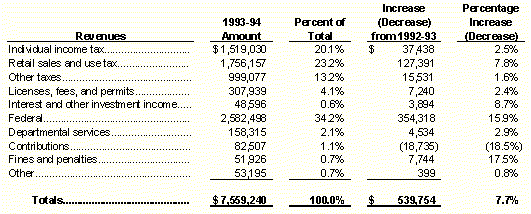
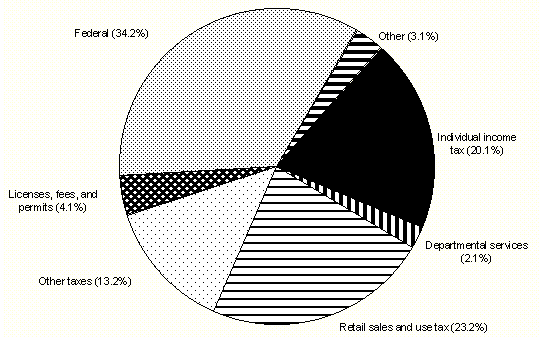
Contributions declined during the fiscal year ended June 30, 1994, because the State was no longer allowed to accept Medicaid disproportionate share monies from private hospitals.
Revenue from fines and penalties increased this year due to increased collections on hazardous waste fines and increases in the collection of vehicle violation fines.
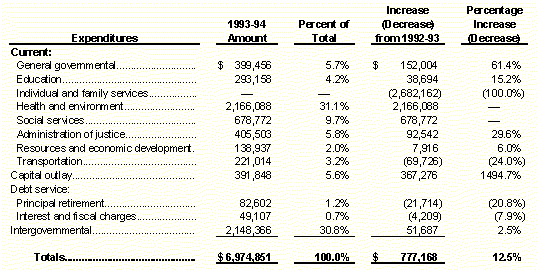
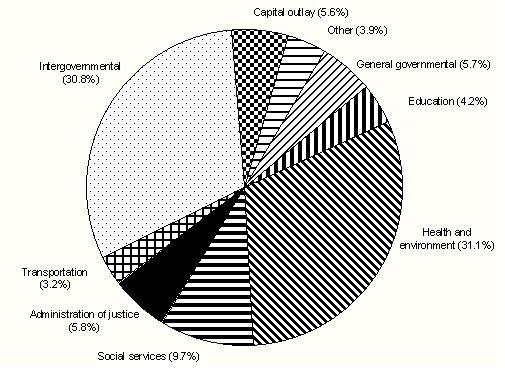
General Governmental expenditures increased during the fiscal year ended June 30, 1994, due to restructuring and as a result of settling the Federal retirees' lawsuit. A new agency, Administrative Law Judges, was added within the General Governmental category, and the functions of several agencies formerly reported in the Individual and Family Services category were transferred to agencies reported within the General Governmental category.
Education spending increased due to the lease of a satellite dish by the South Carolina Educational Television Network and increased textbook purchases by the Department of Education.
Beginning July 1, 1993, the Individual and Family Services agencies were divided into two new functional categories—the Health and Environment function and the Social Services function. Past years were not restated for this change.
Also during the year, a new agency, the Department of Public Safety, was created within the Administration of Justice category. It assumed activities formerly accounted for in the Transportation and General Governmental categories.
The change in the Transportation category resulted from government restructuring. Several activities previously accounted for in that category were transferred to agencies within other functional categories—primarily General Governmental and Administration of Justice.
Debt expenditures for retirement of principal decreased during the fiscal year ended June 30, 1994, because the State paid off $31.4 million in General Obligation (Hurricane Hugo) Notes during the previous year.
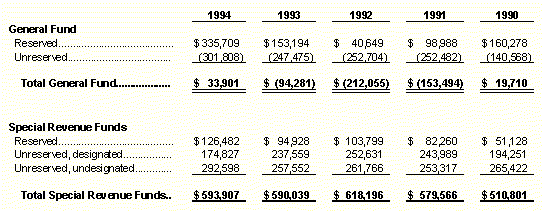
The designated portion of unreserved fund balance reflects tentative plans for future use of available financial resources.
Financial highlights of these segments (expressed in thousands) for the fiscal year ended June 30, 1994, are as follows:

The Public Service Authority (Santee-Cooper) is South Carolina's State- owned public power resource. The Public Service Authority (Santee-Cooper) produces and sells electric power to individuals, businesses, electric cooperatives and municipal power departments. The Public Service Authority (Santee-Cooper) made payments to the State's General Fund of $6.0 million during its fiscal year ended December 31, 1993. The distribution to the General Fund is based primarily on operating cash flows and mandatory reserve requirements.
The Ports Authority develops and maintains State harbors and seaports and handles the commerce through these ports.
Highlights of segment financial information (expressed in thousands) for discretely presented component units for the fiscal year ended June 30, 1994, are presented below:


Moody's Investors Service has rated South Carolina's general obligation bonds as "Aaa," representing the highest rating awarded. For many years, Standard & Poor's also applied its top rating ("AAA") to these bonds. From March 1992 through January 1993, however, Standard & Poor's placed the State "on CreditWatch with negative implications." On January 29, 1993, Standard & Poor's lowered the State's rating on general obligation bonds to "AA+." On October 27, 1993, Fitch Investors Service, Inc., announced its first rating of South Carolina's general obligation bonds. Fitch assigned its top rating of "AAA."
Standard & Poor's has stated that South Carolina must improve the structural balance between its revenues and expenditures and must address the GAAP accumulated deficit in the Budgetary General Fund in order to regain its former "AAA" rating. The fiscal year ended June 30, 1994, marked the second consecutive year in which the State made progress toward those goals. Specifically, the GAAP accumulated deficit was eliminated. Fund equity at June 30, 1994, was $33.9 million. In addition, the General Assembly has enacted legislation to limit appropriations in the Budgetary General Fund beginning in 1994-95. Under the new law, when the General Assembly enacts the annual general appropriations bill, appropriations may not exceed the lesser of:
The State's available legal debt margin at June 30, 1994, was $19.6 million for institution bonds. State law limits annual debt service expenditures rather than directly limiting the amount of outstanding debt for general obligation bonds/notes other than highway bonds, institution bonds, tax anticipation notes, and bond anticipation notes (if any). The annual debt service margin at June 30, 1994, for these bonds was $52.7 million.
Net general obligation bonds/notes outstanding per capita (which excludes general obligation bonds payable from Higher Education Funds) is a useful indicator to citizens, investors and management of the State's debt position. The following table shows these amounts at June 30 for the last three years:


In addition, discretely presented component units had the following amounts of bonds outstanding (expressed in millions) at June 30, 1994:

Legally authorized investments vary by fund, but generally include obligations of the United States and certain agencies of the United States, obligations of the State of South Carolina and certain of its political subdivisions, certificates of deposit, collateralized repurchase agreements and certain obligations of United States corporations.
As provided by law, the State Treasurer deposits money in a general deposit account. The State records earnings of the general deposit account as revenue of the General Fund. The Treasurer deposits other monies into various special deposit accounts, each of which retains its own earnings.
State agencies that issue their own checks participate in pooled bank accounts. These agencies issue checks against the pooled bank accounts. Meanwhile, the State Treasurer invests account balances until the checks clear.
Investment earnings for the General Fund totaled $40.7 million for the fiscal year ended June 30, 1994.
The State conducts various risk control programs to help minimize losses. For example, the health insurance program conducts extensive wellness education programs for covered employees that promote development and maintenance of healthful lifestyles.
The State also administers the Patients' Compensation Fund, an insurance enterprise, which provides medical malpractice insurance.
The audit described above is not intended to meet the requirements of the Federal Single Audit Act of 1984. The Single Audit reports for the State are issued separately.
Again this year, the State will submit its CAFR to the Certificate of Achievement for Excellence in Financial Reporting program of the GFOA. I firmly believe that South Carolina's report for the fiscal year ended June 30, 1994, meets the requirements to receive the Certificate of Achievement.
Special thanks are due to Rob Thompson of the Department of Transportation for providing photographs for this report. In addition, thanks are due to Dr. William C. Gillespie, Chief Economist of the State of South Carolina, and to Philip G. Grose, Jr., Director of the State Budget and Control Board's Executive Institute, who provided invaluable assistance in producing the report.
Sincerely,
EARLE E. MORRIS, JR.
Comptroller General
State of South Carolina